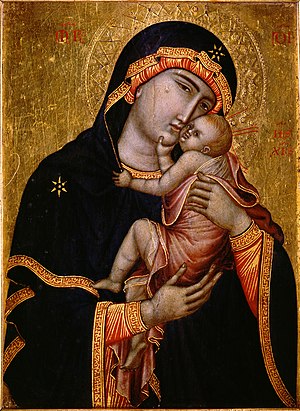
The Cambrai Madonna, also called the Notre-Dame de Grâce, produced around 1340, is a small Italo-Byzantine, possibly Sienese,[1] replica of an Eleusa (Virgin of Tenderness) icon. The work on which it is based is believed to have originated in Tuscany c. 1300, and influenced a wide number of paintings from the following century as well as Florentine sculptures from the 1440–1450s.[2] This version was in turn widely copied across Italy and northern Europe during the 14th and 15th centuries; Filippo Lippi's 1447 Enthroned Madonna and Child is a well known example.
When in 1450 the painting was brought to Cambrai, then part of the Holy Roman Empire ruled by the Dukes of Burgundy and now in France, it was believed an original by Saint Luke, patron saint of artists, for which Mary herself had sat as model. Thus it was treated as a relic; God bestowing miracles on those that travelled to view it.[3][4]
The work is significant beyond its aesthetic value: it serves as a bridge between the Byzantine icon tradition and the Italian Quattrocento, and inspired the work of 15th-century Netherlandish artists. After the Ottoman Turks had conquered Constantinople, copies of the painting were commissioned in the Low Countries in support of Philip the Good's projected crusade, announced at the Feast of the Pheasant but never launched.[5]